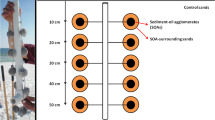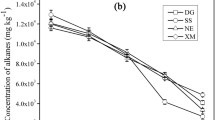Abstract
On Kwajalein Island in the Republic of the Marshall Islands, studies were conducted to characterize subsurface petroleum contamination and assess the potential for bioremediation of contaminated soils and sediments. Because of its remote location and problems with shipment of sample materials off-site, characterization and biotreatability studies were conducted on the Island during a 12-d site visit. Analyses were made of soil contamination levels, physical/chemical properties, and microbial densities, while microcosm studies were made of biodegradation potential. It was found that the coral-derived sands on Kwajalein Island were alkaline (e.g., pH > 8) and deficient in nutrients (e.g., low N, P). Microorganisms were abundant (103−107 org· g−1) and included appreciable hydrocarbon degraders. Diesel fuel contamination ranged from below detection limits to nearly 9000 mg TPH kg−1, with the highest levels in the capillary fringe and upper saturated zone of a freshwater lens beneath the Island. Biodegradation of fresh diesel fuel added to clean soil occurred very slowly (e.g., < 0.5 mg TPH kg−1 d−1). Biodegradation of diesel fuel added to previously contaminated soils that were also supplemented with nutrients, proceeded at higher but still relatively low rates (e.g., < 2 mg TPH kg−1 d−1). It was concluded that bioremediation of diesel fuel contaminated soils by indigenous organisms was feasible on Kwajalein Island, although degradation rates were very low, with some enhancement possible by the addition of nutrients.
Similar content being viewed by others
References
Atlas, R. M. (1991), inIn Situ Bioreclamation, Hinchee, R. E. and Olfenbuttel, R. F. (eds.), Butterworth-Heinemann, Boston, pp. 1–13.
Thomas, J. M. and Ward, C. H. (1989),Environ. Sci. Technol. 23, 760–766.
Dineen, D., Slater, J. P., Hicks, P., Holland, J., and Clendening, L. D. (1990), inPetroleum Contaminated Soils, Kostecki, P. T. and Calabrese, E. J. (eds.), Lewis, Chelsea, MI, pp. 177–187.
Bioremediation of Hazardous Wastes (1992), US Environmental Protection Agency report EPA/600/R-92/126. Office of Research and Development, Washington, DC.
Jolley, R. L., Adler, H. L., Donaldson, T. L., Machanoff, R., MacNeill, J. J., Ott, D. W., Phelps, T. J., Siegrist, R. L., and Walker, J. F. (1992),Bioremediation: Effective treatment of petroleum fuel contaminated soil, a common environmental problem at industrial and governmental agency sites. Proc. Spectrum ’92 Conference. August 1992. Boise, ID. US Department of Energy.
Siegrist, R. L., Korte, N. E., Pickering, D. A., and Phelps, T. J. (1991),Bioremediation of Petroleum-Contaminated Soil on Kwajalein Island: Site Characterization and On-site Biotreatability Studies. Oak Ridge National Laboratory Report, ORNL/TM-11894, Oak Ridge, TN, 227 pp.
Phelps, T. J., Siegrist, R. L., Mackowski, R., and Pfiffner, S. M. (1992), inBioremediation of Petroleum-Contaminated Soil on Kwajalein Island: Microbiological Characterization and Biotreatability Studies, Adler, H. I., Jolley, R. L., and Donaldson, T. L. (eds.), Oak Ridge National Laboratory Report, ORNL/TM-11925, pp. 37–43.
Siegrist, R. L., Phelps, T. J., and Mackowski, R. (1992), inBioremediation of Petroleum-Contaminated Soil on Kwajalein Island: Microbiological Characterization and Biotreatability Studies, Adler, H. I., Jolley, R. L., and Donaldson, T. L. (eds.), Oak Ridge National Laboratory Report, ORNL/TM-11925, pp. 52–69.
Phelps, T. J., Siegrist, R. L., Korte, N. E., Pickering, D. A., Strong-Gunderson, J. M., Palumbo, A. V., Walker, J. F., Morrissey, C. M., and Mackowski, R. (1993),Bioremediation of petroleum hydrocarbons in soil column lysimeters from Kwajalein Island. Proc. 15th Symposium on Biotechnology for Fuels and Chemicals, May 1993, Colorado Springs, CO.
Standard Methods for the Examination of Water and Wastewater (1990), 17th ed., American Public Health Association, Washington, DC.
Methods of Soil Analysis (1965, 1982), Soil Science Society of America Monograph No. 9, Madison, WI, Part I, 1965; Part II, 1982.
Test Methods for Evaluation of Solid Waste (1986), US Environmental Protection Agency, Washington, DC.
Ground-Water Quality Survey No. 38-26-0357-90, U.S. Army Kwajalein Atoll. March 5–16,1990 (1990), US Army Environmental Hygiene Agency, Aberdeen Proving Ground, MD.
Hunt, C. D., Jr. and Peterson, F. L. (1980),Groundwater Resources of Kwajalein Island, Marshall Islands, Technical Report No. 126, Water Resources Center, University of Hawaii, Honolulu.
Author information
Authors and Affiliations
Rights and permissions
About this article
Cite this article
Slegrist, R.L., Phelps, T.J., Korte, N.E. et al. Characterization and biotreatability of petroleum contaminated soils in a coral Atoll in the Pacific Ocean. Appl Biochem Biotechnol 45, 757–773 (1994). https://doi.org/10.1007/BF02941847
Issue Date:
DOI: https://doi.org/10.1007/BF02941847




